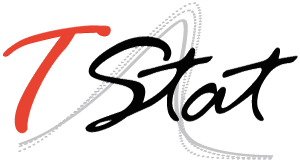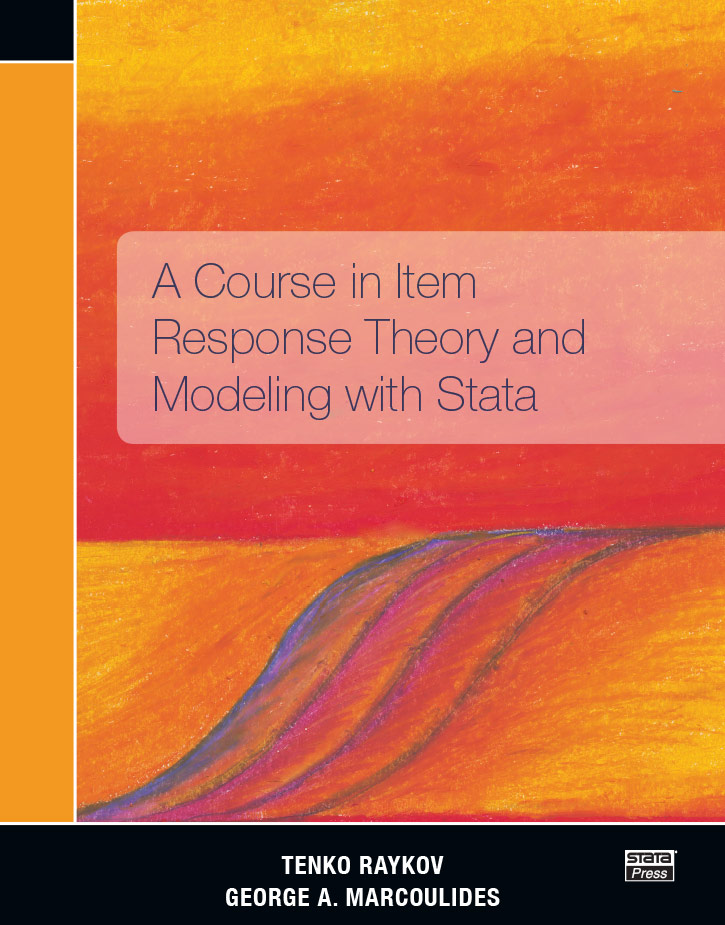A Course in Item Response Theory and Modeling with Stata, by Tenko Raykov and George A. Marcoulides, is a comprehensive introduction to the concepts of item response theory (IRT) that includes numerous examples using Stata’s powerful suite of IRT commands. The authors’ unique development of IRT builds on the foundations of classical test theory, nonlinear factor analysis, and generalized linear models. The examples demonstrate how to fit many kinds of IRT models, including one-, two-, and three-parameter logistic models for binary items as well as nominal, ordinal, and hybrid models for polytomous items.
Chapters 1 and 2 define item response theory and review the statistical concepts and functions that are used to build item response models.
Chapters 3 and 4 discuss classical test theory, factor analysis, and generalized linear models, which provide the conceptual foundations of item response theory.
Chapters 5 and 6 introduce the fundamentals of item response theory and provide examples to illustrate the concepts.
Chapters 7 and 8 cover model fitting, estimation using maximum likelihood theory, item characteristic curves, and information functions.
Chapters 9 and 10 provide a detailed introduction to instrument construction and differential item functioning.
Chapters 11 and 12 introduce IRT models for nominal and ordinal responses as well as multidimentional IRT models.
A Course in Item Response Theory and Modeling with Stata is an outstanding text both for those who are new to IRT and for those who are familiar with IRT but new to fitting these models in Stata. It is a useful text for IRT courses and for researchers who use IRT.
List of figures
List of tables
Preface
Notation and typography
1. WHAT IS ITEM RESPONSE THEORY AND ITEM RESPONSE MODELING?
A definition and a fundamental concept of item response theory and item response modeling
The factor analysis connection
What this book is, and is not, about
Chapter conclusion
2. TWO BASIC FUNCTIONS FOR ITEM RESPONSE THEORY AND ITEM RESPONSE MODELING AND INTRODUCTION TO STATA
The normal ogive
The normal distribution probability density function
The normal ogive function
The logistic function and related concepts
Definition, notation, and graph of the logistic function
Invertibility of the logistic function, odds, and logits
The relationship between the logistic and normal ogive functions and their use to express response probability
Expressing event or response probability in two distinct ways
Alternative response probability as closely related to the logistic function
Chapter conclusion
3. CLASSICAL TEST THEORY, FACTOR ANALYSIS, AND THEIR CONNECTIONS TO ITEM RESPONSE THEORY
Brief visit to classical test theory
The classical test theory decomposition (classical test theory equation)
Misconceptions about classical test theory
Binary random variables: Expectation and probability of a prespecified response
Why classical test theory?
A short introduction to classical factor analysis
The classical factor analysis model
Model parameters
Classical factor analysis and measure correlation for fixed factor values
Chapter conclusion
4. GENERALIZED LINEAR MODELING, LOGISTIC REGRESSION, NONLINEAR FACTOR ANALYSIS, AND THEIR LINKS TO ITEM RESPONSE THEORY AND ITEM RESPONSE MODELING
Generalized linear modeling as a statistical methodology for analysis of relationships between response and explanatory variables
The general linear model and its connection to the classical factor analysis model
Extending the linear modeling idea to discrete response variables
The components of a generalized linear model
Logistic regression as a generalized linear model of relevance for item response theory and item response modeling
Univariate binary logistic regression
Multivariate logistic regression
Nonlinear factor analysis models and their relation to generalized linear models
Classical factor analysis and its connection to generalized linear modeling
Nonlinear factor analysis models
Chapter conclusion
5. FUNDAMENTALS OF ITEM RESPONSE THEORY AND ITEM RESPONSE MODELING
Item characteristic curves revisited
What changes across item characteristic curves in a behavioral measurement situation?
Unidimensionality and local independence
What are the implications of unidimensionality?
A formal definition of local independence
What does it mean to assume local independence in an item response theory setting?
A general linear modeling property yielding test-free and group-free measurement in item response modeling
One more look at the logistic function
The one- and two-parameter logistic models
The two-parameter logistic model
Interpretation of the item parameters in the two-parameter logistic model
The scale of measurement
The one-parameter logistic model
The one-parameter logistic and two-parameter logistic models as nonlinear factor analysis models, generalized linear models, and logistic regression models
Important and useful properties of the Rasch model
The three-parameter logistic model
The logistic models as latent variable models and analogs to nonlinear regression models
Item response models as latent variable models
The logistic models as analogs to nonlinear regression models
Chapter conclusion
6. FIRST APPLICATIONS OF STATA FOR ITEM RESPONSE MODELING
Reading data into Stata and related activities
Fitting a two-parameter logistic model
Testing nested item response theory models and model selection
Fitting a one-parameter logistic model and comparison with the two-parameter logistic model
Fitting a three-parameter logistic model and comparison with more parsimonious models
Estimation of individual subject trait, construct, or ability levels
Scoring of studied persons
Chapter conclusion
7. ITEM RESPONSE THEORY MODEL FITTING AND ESTIMATION
Introduction
Person likelihood function for a given item set
Likelihood reexpression in log likelihood
Maximum likelihood estimation of trait or ability level for a given person
A brief visit to the general maximum likelihood theory
What if (meaningful) maximum likelihood estimates do not exist?
Estimation of item parameters
Standard errors of item parameter estimates
Estimation of item and ability parameters
Testing and selection of nested item response theory models
Item response model fitting and estimation with missing data
Chapter conclusion
8. INFORMATION FUNCTIONS AND TEST CHARACTERISTIC CURVES
Item information functions for binary items
Why should one be interested in item information, and where is it maximal?
What else is relevant for item information?
Empirical illustration of item information functions
Test information function
Test characteristic curve
The test characteristic curve as a nonlinear trait or ability score transformation
Chapter conclusion
9. INSTRUMENT CONSTRUCTION AND DEVELOPMENT USING INFORMATION FUNCTIONS
A general approach of item response theory application for multi-item measuring instrument construction
How to apply Lord’s approach to instrument construction in empirical research
Examples of target information functions for applications of the outlined procedure for measuring instrument construction
Assumptions of instrument construction procedure
Discussion and conclusion
10. DIFFERENTIAL ITEM FUNCTIONING
What is differential item functioning?
Two main approaches to differential item functioning examination
Observed variable methods for differential item functioning examination
Using Stata for studying differential item functioning with observed variable methods
Item response theory based methods for differential item functioning examination
Chapter conclusion
Appendix. The Benjamin–Hochberg multiple testing procedure: A brief introduction
11. POLYTOMOUS ITEM RESPONSE MODELS AND HYBRID MODELS
Why do we need polytomous items?
A key distinction between item response theory models with polytomous and dichotomous items
The nominal response model
An empirical illustration of the nominal response model
The partial credit and the rating scale models
Partial credit model
Rating scale model
The generalized partial credit model
The graded response model
Comparison and selection of polytomous item response models
Hybrid models
The three-parameter logistic model revisited
Chapter conclusion
12. INTRODUCTION TO MULTIDIMENSIONAL ITEM RESPONSE THEORY AND MODELING
Limitations of unidimensional item response theory
A main methodological principle underlying multidimensional item response theory
How can we define multidimensional item response theory?
A main class of multidimensional item response theory models
Fitting multidimensional item response theory models and comparison with unidimensional item response theory models
Fitting a multidimensional item response theory model
Comparing a multidimensional model with an unidimensional model
Chapter conclusion
13. EPILOGUE
References
Author index
Subject index


